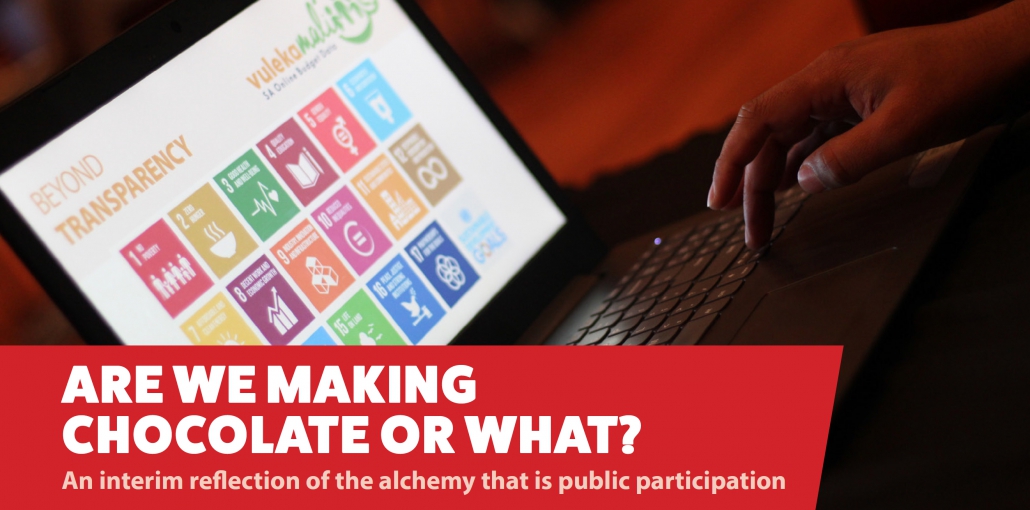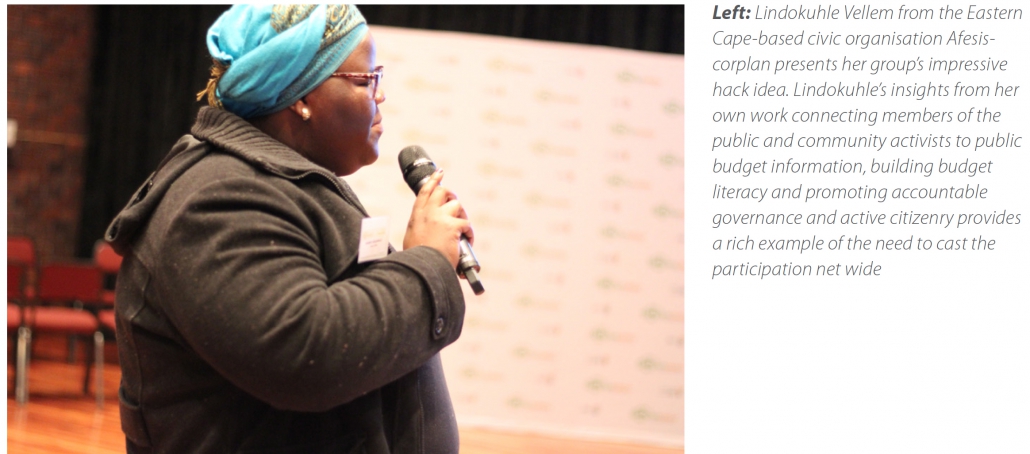
By Zukiswa Kota (IMALI YETHU Lead Coordinator, Public Service Accountability Monitor)
Article originally published in OPEN, Edition 3.
.
An open data project involving both civic and state actors was always going to elicit varying “ and various – perspectives on a range of issues.
The Vulekamali team consists of government officials, members of civil society, academics and the project implementing agent. Recently “ our team discussions have begun to feel somewhat microcosmic of our broader national context where robust, honest and ultimately constructive discussions about governance and decision-making are concerned. I was reminded of a statement from a 2005 book entitled Budget Transparency and Participation;
Openness in government decisionmaking, the availability of budget and outcomes data and the effective management of government constituencies in budget debates are inseparable. The release of better information by the executive branch will not mean much unless coupled with efforts in the legislature and civil society to use that information. Similarly, it is difficult for the executive to establish accurately what information and institutional provisions are most urgently needed in the absence of a dialogue with legislatures and civil society. Only through a vibrant budget debate will the potential benefits of transparency be realised [1]
As the Vulekamali project team, circumstance often prompts us to factor our heterogeneous perspectives into our work. This has encouraged[2] a number of us to reflect on the objectives and related assumptions we held prior to joining the team. We’ve also come to share a number of buzzwords; some novel, others well-used. These include the concepts of accountability, project agility[3], transparency and public participation. The latter in particular is undeniably central to the development of Vulekamali. It is both a means to an end and arguably an end in itself.

We hope to inspire the participation of a multitude of actors in Vulekamali’s development as well to use Vulekamali to promote public participation in South Africa’s budget process. In the past year, we’ve had a number of frank, sometimes painful but always constructive project discussions about the process of ensuring wider public participation. These have often revealed what occasionally feels like a gaping chasm between our shared commitment to the process and our actual practice to ensure meaningful participation.
Have we made some risky assumptions about public participation? Do we even have a shared perspective of what meaningful participation looks like? My sense of the answers to these questions is that we’ve made very many such assumptions and that we don’t have a common definition of this kind of participation. This, however, is not necessarily a negative thing. In fact, if interrogated in a robust and solutionoriented manner, these differences may serve to allow the progressive, robust development of Vulekamali.
The project charter sets out some very ambitious objectives including ensuring public participation across all nine provinces of South Africa, building a 1000 beta user group and encouraging the contribution of government and civic actors beyond the project team. Time consuming? Yes. Budget intensive? Certainly. Politically complex? Inescapably. Energy intensive? Undeniably.
A former member of the project team, Dr. Kay Brown once used the following analogy to explain the complexity and novelty of the project; ˜it’s a bit like trying to make chocolate from scratch when you have no idea what chocolate is or what it’s actually supposed to taste like’
This can lead to some frustration even when guided by the best-laid plans. At the core of this are relationships founded on mutual trust and respect. Building such relationships that encourage vibrant debate takes time. The same is true for the kind of participation we seek from communities across South Africa. Fostering meaningful participation is resource intensive. It involves a degree of trust-building and like the bitter cocoa bean “ it can yield wonderful results with some careful, patient alchemy.
In keeping with the project’s ethos of accountable and prudent use of public resources; the question of value for money in public participation activities is central.
What isn’t easy to determine is how to measure this. What trade-offs will we ultimately need to make to ensure this balance? What is certain is that we are collectively accountable for ensuring that we respect the integrity of participation that is inclusive, rigorous and genuinely accommodates diverse views.
This is an opportune moment to bring other role-players into the fold. We seek to reiterate the call for other civic actors and public officials to join us in making ˜the circle’ wider and more inclusive. President Ramaphosa has on several occasions emphasized the importance of state-civic partnerships. We call on other government departments, parliamentarians, and civic actors to share concrete experiences of successful public participation. Can we learn from the Department of Planning, Monitoring and Evaluations’ Community Based Monitoring initiatives, for instance? Are there secret ingredients that could add the richness and quality we seek?
With more reflection and input “ we will confidently grind, winnow, and conch towards good quality, value-for-money African ˜chocolate’!

